
I have been wanting to reread the works of C.S. Lewis and then rank them in order of best to worst. This will probably take me most of 2024 to do it. But while I work through his magnus opus, I wanted to reread The Chronicles of Narnia and rank them. It is important to note that these rankings are not just based on my personal preference. There are a number of factors involved, which I explain below. If you haven’t read The Chronicles of Narnia (or you haven’t read them since you were a kid), I hope this blog post will provoke you to pick them up and give them a read.
*******************************
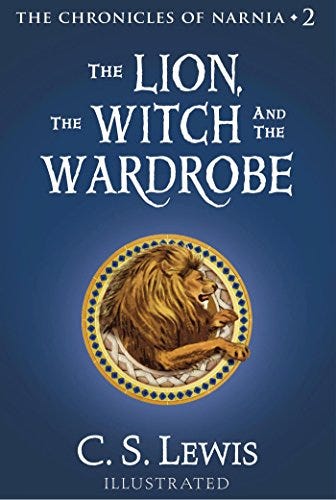
Ranking: 27.3 (out of 30)
Theological content 4.8
Readability 4.3
Character development 4.3
Originality 4.8
Cultural influence 4.5
Personal Engagement 4.6
Summary
Four children (Peter, Susan, Edmund and Lucy) wander into a wardrobe, in one of the rooms at the Professor’s house, bringing them into the magical world of Narnia. Edmund and Lucy found themselves in the world first, but only Edmund interacted with the White Witch, who deceived him to betray his siblings. The White Witch caused Narnia to be in a perpetual winter, under her evil spell. There is a prophecy that two sons of Adam and two daughters of Eve are to ascend to the Four Thrones.
Here again the reader is introduced to Aslan, the Great Lion, who agrees to give up his life to save Edmund. Ultimately, Aslan comes back to life through the power of Deep Magic and ends the reign of the White Witch. The story ends with the four siblings ascending to their thrones as the new Kings and Queens of Narnia.
Favorite quotes
“Logic!” said the Professor, half to himself, “Why don’t they teach logic at these schools? There are only three possibilities. Either your sister is telling lies, or she is mad, or she is telling the truth. You know she doesn’t tell lies and it is obvious that she is not mad. For the moment then and unless further evidence turns up, we must assume that she is telling the truth.” (Professor Kirke, page 32)
“Wrong will be right, when Aslan comes in sight, At the sound of his roar, sorrows will be no more, When he bares his teeth, winter meets its death, And when he shakes his mane, we shall have spring again.” (Old rhyme, page 49)
“Safe?” said, Mr. Beaver, “don’t you hear what Mrs. Beaver tells you? Who said anything about safe? Course he isn’t safe. But he’s good. He’s the King, I tell you.” (Beaver, page 50)
“Work against the Emperor’s Magic?” said Aslan, turning to her with something like a frown on his face. And nobody ever made that suggestion to him again.” (Aslan, page 86)
Theological themes
Suffering, evil, forgiveness, substitution, redemption, atonement, grace
Personal musings
This is the most theologically rich work of the Narnian series. Lewis’ view of the atonement is fascinating, reinforcing the question of his attachment to the ransom theory. In general, this work is not only theologically robust, but theologically comprehensive. It is also very personal. Betrayal, grace and forgiveness are highlighted in the Edmund character. These are some of the reasons it is the most popular and most beloved story in the series.
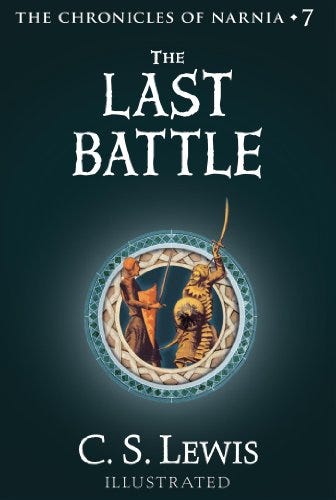
Ranking: 26.9 (out of 30)
Theological content 4.8
Readability 4.3
Character development 4.0
Originality 4.8
Cultural influence 4.3
Personal Engagement 4.7
Summary
The last of the Narnian books begins with an ape named Shift. This was a very smart ape and he has a friend (but this friend was more like a slave) named Puzzle, who is a donkey. Many years have passed and no one had seen Aslan in a very long time. The current king of Narnia, King Tirian, was actually the last king of Narnia, though he didn’t know it. Shift had this idea to dress up Puzzle with the skin of a lion and act like he was the great and mighty Aslan. Shift did not believe in Aslan and actually he seemed to be sympathetic to Tash, the god of the Calormene people (this country was described in detail in The Horse and the Boy). Through the ingenuity of Shift and the help of a strange cat, the creatures of Narnia were convinced that Aslan had returned, but this Aslan was not good. He seemed to be an angry Lion, caring about the desires of the Calormene leaders, rather than the deep magic of Narnia. King Tirian needs help and calls on Aslan to rescue Narnia from this deception. Aslan sends Eustace and Jill back to Narnia to help. With the help of Eustace and Jill, Aslan returns and the deep magic of Narnia is restored, while the religion of Tash is found out to be fraudulent.
Eustace and Jill witness the end of Old Narnia and the birth of New Narnia, which is a depiction of the new earth, prophesied in the book of Revelation. The four children and a number of others join them in a joyous reunion. The end is here, but not really. It is just the beginning.
Favorite quotes
“Tash is only another name for Aslan. All that old idea of us being right and the Calormenes wrong is silly. We know better now. The Calormenes use different words but we all mean the same thing. Tash and Aslan are only two different names for you know Who. That’s why there can never be any quarrel between them.” (Shift, page 23)
“And then she understood the devilish cunning of the enemies’ plan. By mixing a little truth with it they had made their lie far stronger.” (Narrator, page 102)
“My sister Susan,” answered Peter shortly and gravely, “is no longer a friend of Narnia.” (Peter, page 145)
“Yes,” said Queen Lucy. “In our world too, a stable once had something inside it that was bigger than our whole world.” (Lucy, page 157)
“Yet I have been seeking Tash all my days. Beloved, said the Glorious One, unles they desire had been for methou wouldst not have sought so long and so truly. For all find what they truly seek.” (Emeth, page 174)
“And this is the marvel of marvels, that he called me Beloved, me who am but as a dog — ” (Emeth, page 174)
Theological themes
Heaven, religious syncretism, judgment
Personal musings
This was quite a book. Philosophically speaking, it has no equal within the seven books. The way Lewis deals with syncretism between the religion of Aslan and Tash is helpful and again, very different than the other books in the Narnian series. Furthermore, the second half of this book has transformed my view of Heaven in a way that no other book (other than the bible) ever has. It is because of these pages that my love for theological fiction was reawakened. If the whole book was like this, it may have been my favorite book in the series. The phrase “further up and further in” is permanently etched in my mind whenever I think of Heaven. Quite frankly, whether Lewis meant to or not, the New Creation eschatological model is substantially in debt to Lewis and his thinking about the afterlife. I couldn’t imagine a better way to end this legendary series.
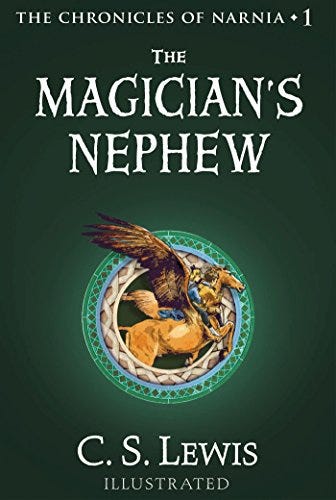
Ranking: 25.7 (out of 30)
Theological content 4.7
Readability 4.3
Character development 4.2
Originality 4.7
Cultural influence 3.0
Personal Engagement 4.8
Summary
Two kids, neighbors, in London. Their names are Polly and Digory. Digory lived with his aunt and uncle, who were siblings, not married. Uncle Andrew was a strange man. One day they were exploring and somehow found themselves in Uncle Andrew’s study. This tall, very skinny, unkempt man was said to have been doing experiments in his room. When the children found themselves there, they saw a set of yellow rings and a set of green rings. Polly touched the yellow ring and suddenly Polly vanished, entering into a magical world. Digory soon followed. And actually, those children saw not one, but a couple magical worlds.
The journey into these worlds introduced Polly and Digory to magic, evil and even the creation of Narnia. This story is vital to a correct understanding of the rest of this children’s series. Many theological themes are addressed, though with the typically Lewis wit and subtlety. Jadis, the antagonist, is haunting and without question, the most intiguing character in book one.
Polly and Digory make it back, making sure the magical rings were safely away from Uncle Andrew or anyone who could use the magic for future nefarious reasons. Was the magic hidden forever? The rest of the books answer this question.
Favorite quotes
“Grown-ups are always thinking of uninteresting explanations.” (Digory, page 10)
“Men, like me, who possess hidden wisdom, are freed from common rules just as we are cut off from common pleasures. Ours, my boy, is a high and lonely calling.” (Uncle Andrew, page 21)
“Now that she had Uncle Andrew, she took no notice of Digory. I expect most witches are like that. They are not interested in things or people unless they can use them, they are terribly practical.” (Referring to Jadis, page 79)
Theological themes
Creation, evil, demons
Personal musings
In truth, this is my favorite book of the series. The only reason why it is placed third is because of its minimal cultural impact, compared to The Lion, The Witch and the Wardrobe and The Last Battle. I find the character of Jadis and the Magician fascinating. Also, watching Aslan sing Narnia into existence is beautiful and even haunting. The idea of previous or alternate worlds or existences is subtle, but part of Lewis’ thinking. Concepts like the Jinn are brought up in this book, though never really explained. It is a tightly written work.
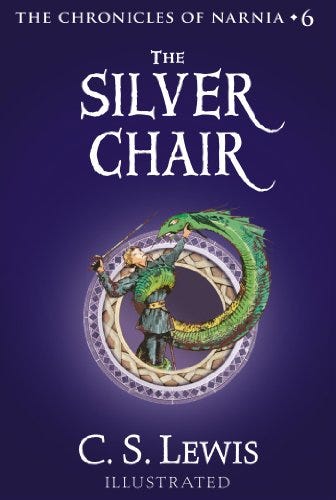
Ranking: 25.6 (out of 30)
Theological content 4.6
Readability 4.3
Character development 4.8
Originality 4.3
Cultural influence 3.0
Personal Engagement 4.6
Summary
This is book six of the series and the first time we are introduced to Jill Pole. Eustace Scrubb is back and is a schoolmate of Jill’s. Eustace confides in Jill about his journeys in Narnia and Jill asked if it is possible to return to Narnia. Eustace isn’t sure but he decides to ask Aslan to bring both of them to Narnia. Aslan grants their request.
On their arrival to Narnia, Jill is given a task by Aslan himself. The task is to find a prince, who was taken away from the current king of Narnia many years ago. All of Narnia and the King himself, who is the great King Caspian in previous adventures, believes him to be dead, but he is not. During this epic journey, Eustace and Jill are introduced to Puddleglum, a Marshwiggle, who is some species created by Lewis. Puddleglum is basically a Marshwiggle version of Eeyore, but ends up being heroic in the end. After many struggles and victories, the Prince is found and the aged King can die a happy man.
Favorite quotes
“Are you not thirsty?” said the Lion. “I’m dying of thirst,” said Jill. “Then drink,” said the Lion. “May I — could I — would you mind going away while I do?” said Jill. The Lion answered this only by a look and a very low growl. “Will you promise not to — do anything to me, if I do come?” said Jill. “I make no promise,” said the Lion. (Aslan, page 22)
“Do you eat girls?” she said. “I have swallowed up girls and boys, women and men, kings and emperors, cities and realms,” said the Lion. It didn’t say this as if it were boasting, nor sorry, nor angry. It just said it. “I dare not come and drink,” said Jill. “Then you will die of thirst,” said the Lion. “Oh dear!” said Jill, coming a step closer. “I suppose I must go and look for another stream then.” “There is no other stream.” said the Lion. (Aslan, page 22)
“You would not have called to me unless I had been calling to you.” said the Lion. (Aslan, page 24)
Theological themes
Evil, worldly allurement, sacrifice, resurrection
Personal musings
In the Silver Chair, Lewis returns to depicting evil in a very real and tangible way. The iterations of Satan are seen through his Narnian works, and though this version is not as potent as Jadis or the White Witch, it is spellbinding enough. But what I liked most about this book is Puddleglum. His strange, pessimistic, heroic nature is a departure from Lewis’ norm, but a welcome addition. Oh, and the jaunt into the town of the Giants reminding me of the temptations spoken often by Bunyan, trying to get true followers of Jesus distracted from the safety of the narrow road.
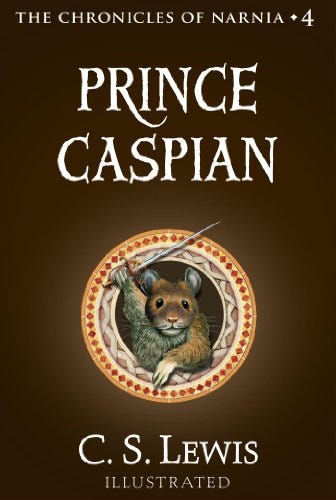
Ranking: 25.1 (out of 30)
Theological content 4.2
Readability 4.3
Character development 4.8
Originality 3.8
Cultural influence 4.0
Personal Engagement 4.2
Summary
The four children, Peter, Susan, Edmund and Lucy are sitting at a railway station, on their way back to school. It has been a year since they have returned back to our world from a lifetime of adventures in Narnia. Suddenly, without warning, the children were pulled back into Narnia. The reason for their return is focused on Caspian, the true king of Narnia, who needs their help. His uncle, King Miraz, has occupied the throne and has just bore a child. Caspian’s life is in danger and even more troubling, King Miraz is no friend to Aslan. If he has his way, Narnia would never speak of Aslan again.
The four children return after hundreds of years have passed, called by the power of Susan’s horn, to establish Caspian’s reign. In this book we are introduced to Trumpkin, the legendary dwarf and Reepicheep, the bold mouse, whose bravado makes even Aslan laugh. Lewis brings us into another classic battle of good and evil and for Peter and Susan, this is their final adventure in Narnia.
Favorite quotes
“Welcome child,” he said. “Aslan,” said Lucy, “you’re bigger.” “That is because you are older, little one,” answered he. “Not because you are?” “I am not.” But every year you grow, you will find me bigger.” (Aslan, page 79)
“To know what would have happened, child?” said Aslan. “No. Nobody is ever told that.” (Aslan, page 79)
“Lucy went first, biting her lip and trying not to say all the things she thought of saying to Susan. But she forgot them when she fixed her eyes on Aslan.” (Narrator, page 84)
“You come of the Lord Adam and Lady Eve,” said Aslan. “And that is both honor enough to erect the head of the poorest beggar, and shame enough to bow the shoulders of the greatest emperor on earth. Be content.” (Aslan, page 123)
Theological themes
Evil, faith
Personal musings
As I stated in my assessment of The Voyage of the Dawn Treader, this work was a coin flip regarding my least favorite after The Horse and His Boy. I ultimately put this ahead of the Dawn Treader because of its cultural importance, making it to the silver screen. Characters such as Reepicheep are part of the genius of Lewis. Endearing, magical, hopeful. These are the scenes that cause the reader to hope that animals talk in the life to come. But please don’t misunderstand, I love The Chronicles of Narnia. Each book (other than The Horse and the Boy) mesmorized me to some degree. But the purpose of this exercise is to give reasons for my list.

Ranking: 24.7 (out of 30)
Theological content 4.4
Readability 4.3
Character development 4.3
Originality 4.3
Cultural influence 3.0
Personal Engagement 4.4
Summary
Edmund and Lucy went to stay with their cousin, Eustace Scrubb, for the summer. Eustace was a temperamental person, who disliked everyone, but he didn’t mind these two coming for a visit. One day they were all sitting in Lucy’s room and suddenly the painting of a ship came to life, magically absorbing them back to Narnia. The three children found themselves on the ship, whose captain was Caspian, the boy king, whom they met in a previous adventure. The reason for being pulled back into Narnia was to look for Caspian’s seven friends who were banished by Caspian’s Uncle Miraz, but also to look for the World’s End or Aslan’s own country.
This journey proved perilous and Reepicheep, the great mouse, one of Lewis’ greatest inventions, travelled to the World’s End with the company of Edmund, Lucy and Eustace. But only Reepicheep was meant to go into the final unknown. This adventure proved life changing for the three children, but uniquely for Eustace.
Favorite quotes
“The very first tear he made was so deep that I thought it had gone right into my heart. And when he began pulling the skin off, it hurt worse than anything I’ve ever felt. The only thing that made me able to bear it was just the pleasure of feeling the stuff peel off. You know — if you’ve ever picked the scab off a sore place. It hurts like billy-oh but it is such fun to see it coming away.” (Eustace, page 59)
“That’s all right,” said Edmund. “Between ourselves, you haven’t been as bad as I was on my first trip to Narnia. You were only an ass, but I was a traitor.” (Edmund, page 60)
“I am,” said Aslan. “But there I have another name. You must learn to know me by that name. This was the very reason why you were brought to Narnia, that by knowing me here for a little, you may know me better there.” (Aslan, page 142)
Theological themes
Regeneration, sanctification, heaven, angels
Personal musings
Behind The Horse and the Boy, it is a coin flip whether this work or Prince Caspian was the next least favorite of the series. Lewis’ thoughts seem scattered here, adding a number of tangents, which though fascinating, seem a bit out of place. That being said, the transformation of Eustace was beautiful. Undoubtedly, one of the most intriguing scenes, relating to the concepts of regeneration and/or sanctification. Furthermore, the personification of stars and the Sea People were interesting, but again, Lewis just drops these literary bombs, with no explanation attached. Lastly, there is almost no clear depiction of evil or a manifestation of Satan, which is a staple of the Narnian books.
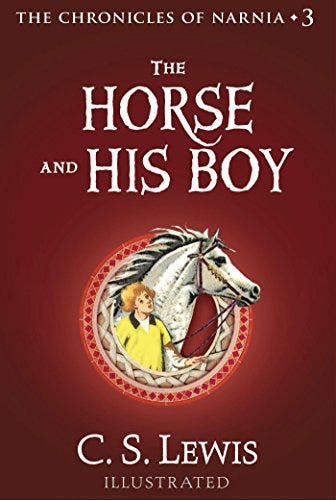
Ranking: 22.7 (out of 30)
Theological content 3.5
Readability 4.3
Character development 4.3
Originality 4.0
Cultural influence 3.0
Personal Engagement 3.7
Summary
This story is set during the reign of High King Peter, Queen Susan, King Edmund, Queen Lucy. The story begins with two children, Shasta and Aravis, running away from their lives. Shasta, being on the threshold of being sold into slavery and Aravis, being forced to marry someone who she does not love. Both these children are looking for freedom and have been told that the land of Narnia is where freedom lies.
Shasta, with a desire to run away with his family horse, one day wished in jest that his horse could speak. Shockingly, the horse could speak. His name was Bree and he was born a free animal in Narnia, but was taken into slavery. Soon, Shasta met up with Aravis and she also had a talking horse named Hwin. Together they headed towards Narnia.
This story is set within the country of Calormen, a place that knows nothing of the magic of Narnia. Queen Susan is being courted by the prince of that country, yet she wants nothing to do with him. Because of this rejection, the Calormen attempt to conquer Narnia.
Ultimately, Shasta realizes his real name is Cor, he has a twin brother Corin and he was taken from his father, the King of Archenland, years before. Their reunion is sweet and in time, Cor becomes the King, marrying Aravis, his childhood friend.
Narnia defeats the Calormen and freedom is enjoyed by the two children and their horses. Everyone is free in Narnia.
Favorite quotes
“Child,” said the Voice, “I am telling you your story, not hers. I tell no one any story but his own.” (Aslan, page 84)
“Who are you?” asked Shasta. “Myself,” said the Voice, very deep and low so that the earth shook. (Shasta, page 84)
“It was I who wounded you,” said Aslan. “I am the only Lion you met in all your journeyings. Do you know why I tore you?” (Aslan, page 111)
Theological themes
Sanctification, providence, freedom
Personal musings
This was my least favorite of the Narnian books. The development of the story took too long and though I understand the reason for the existence of the Calormen and their place in the later Narnian books, it was not interesting to me. Furthermore, the main characters were somewhat bland. Bottom line, this work could be removed and it would take nothing away from the series.
